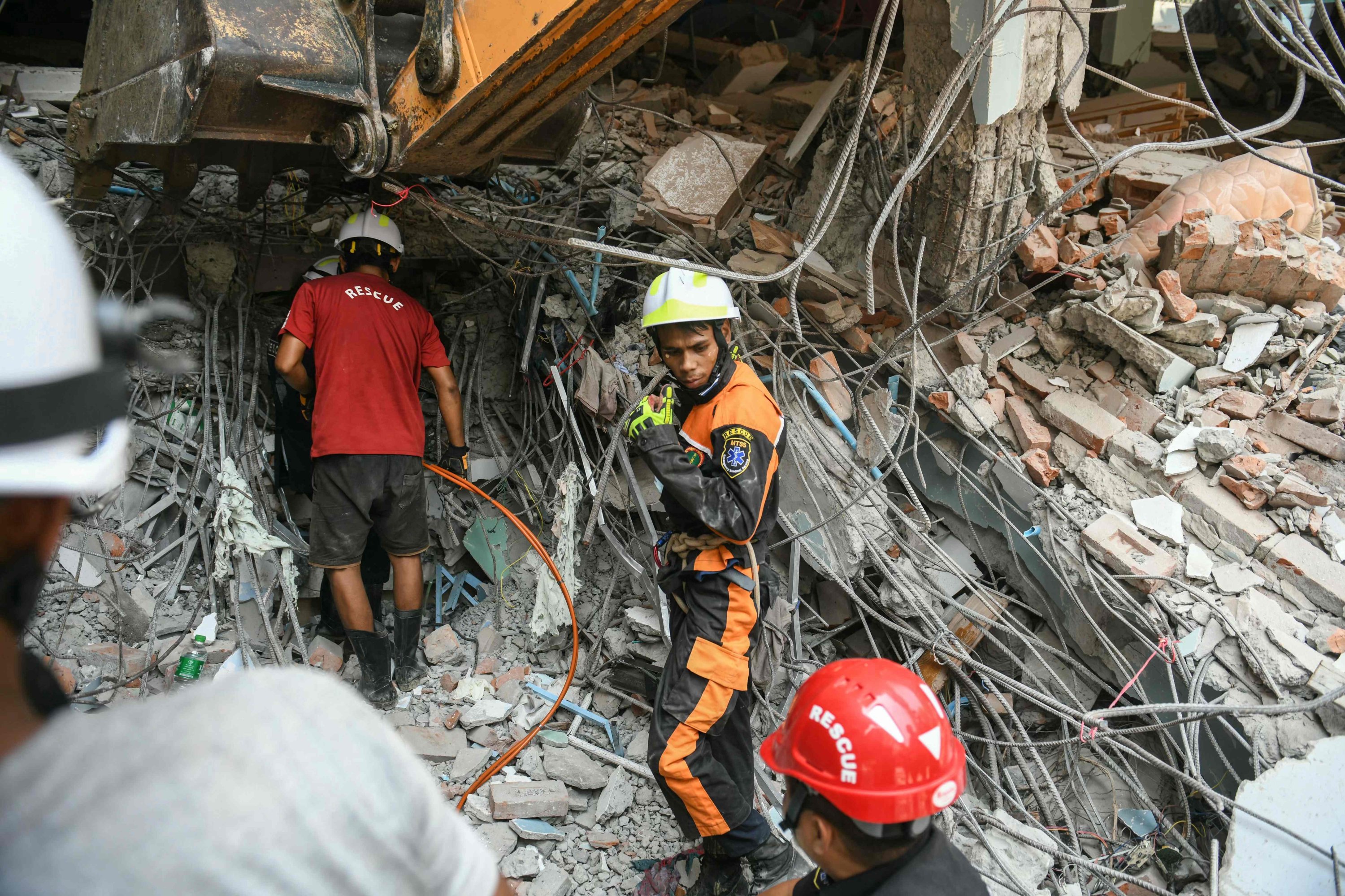© Turkuvaz Haberleşme ve Yayıncılık 2025
The death toll from a powerful 7.7 magnitude earthquake in Myanmar soared past 1,000 on Saturday as rescuers pulled more bodies from the rubble of collapsed buildings near the country’s second-largest city.
Myanmar’s military-led government said 1,002 people have been confirmed dead, with 2,376 injured and 30 still missing. Officials warned the numbers could climb further, stating that “detailed figures are still being collected.”
The disaster struck as Myanmar grapples with a prolonged and bloody civil war, which has already triggered a massive humanitarian crisis. The conflict has made travel across the country both difficult and dangerous, hampering relief efforts and raising fears that the death toll could rise even higher.
The earthquake hit at midday Friday near Mandalay, followed by several aftershocks, including one measuring a strong 6.4 magnitude. It sent buildings toppling, buckled roads, collapsed bridges and burst a dam.
In the capital, Naypyidaw, crews worked Saturday to repair damaged roads, while electricity, phone and internet services remained down in most of the city.
The earthquake destroyed several buildings, including multiple units housing government civil servants, but that section of the city was blocked off by authorities.
In neighboring Thailand, the quake rocked the greater Bangkok area, home to about 17 million people, many of whom live in high-rise buildings, as well as other parts of the country.
Bangkok authorities said six people were confirmed dead, 26 injured and 47 missing, most from a construction site near the capital’s popular Chatuchak market.
When the quake struck, a 33-story high-rise being built by a Chinese firm for the Thai government wobbled before crashing to the ground in a massive plume of dust, sending people screaming and fleeing.

On Saturday, heavy equipment was brought in to clear the rubble, but hope was fading among friends and family of the missing.
“I was praying they had survived, but when I got here and saw the ruin—where could they be? In which corner? Are they still alive? I am still praying that all six are alive,” said 45-year-old Naruemol Thonglek, sobbing as she awaited news about her partner, who is from Myanmar, and five friends who worked at the site.
“I cannot accept this. When I see this, I can’t accept this. A close friend of mine is in there, too,” she said.
Waenphet Panta said she hadn’t heard from her daughter, Kanlayanee, since a phone call about an hour before the quake. A friend told her Kanlayanee had been working high on the building that day.
“I am praying my daughter is safe, that she has survived and that she’s at the hospital,” she said, with Kanlayanee’s father sitting beside her.
Earthquakes are rare in Bangkok but relatively common in Myanmar, which sits on the Sagaing Fault, a major north-south fault that separates the India Plate and the Sunda Plate.
Brian Baptie, a seismologist with the British Geological Survey, said a 125-mile section of the fault appeared to rupture for just over a minute, with a slip of up to 16 feet in places, causing intense ground shaking in an area where many people live in timber and unreinforced brick masonry buildings.
“When you have a large earthquake in an area with over a million people, many of them in vulnerable buildings, the consequences can often be disastrous,” he said.
“From initial reports, that seems likely to be the case here.”
Myanmar’s government said blood was in high demand in the hardest-hit areas. In a country where previous governments have sometimes been slow to accept foreign aid, military leader Min Aung Hlaing said Myanmar was ready to receive outside assistance.
Myanmar’s military seized power from the elected government of Aung San Suu Kyi in February 2021 and is now locked in a civil war with long-established militias and newly formed pro-democracy groups.
Government forces have lost control of much of the country, making many areas too dangerous or inaccessible for aid groups. More than 3 million people have been displaced by fighting, and nearly 20 million are in need, according to the United Nations.
“Although a full picture of the damage is still emerging, most of us have never seen such destruction,” said Haider Yaqub, Myanmar country director for the NGO Plan International, from Yangon.
“Without a doubt, the humanitarian needs will be significant.”
China and Russia, Myanmar’s largest suppliers of weapons, were among the first to send humanitarian aid.
A 37-member team from China’s Yunnan province arrived in Yangon early Saturday with earthquake detectors, drones and other supplies, the official Xinhua News Agency reported.
Russia’s Emergencies Ministry dispatched two planes carrying 120 rescuers and supplies, according to Russian state news agency Tass.
India sent a search and rescue team along with a medical team and provisions, while Malaysia’s Foreign Ministry said the country would send 50 people Sunday to help identify and assist the worst-hit areas.
South Korea announced it would provide $2 million in humanitarian aid through international organizations to support recovery efforts. The Foreign Ministry said Seoul would closely monitor the situation and consider additional support if needed.
The United Nations allocated $5 million to kick-start relief efforts.
U.S. President Donald Trump said Friday that the United States would help with the response, but some experts voiced concerns about the effort given his administration’s deep cuts to foreign aid.
The Trump administration’s reductions to the U.S. Agency for International Development have already forced the U.N. and non-governmental organizations to scale back many programs in Myanmar.
